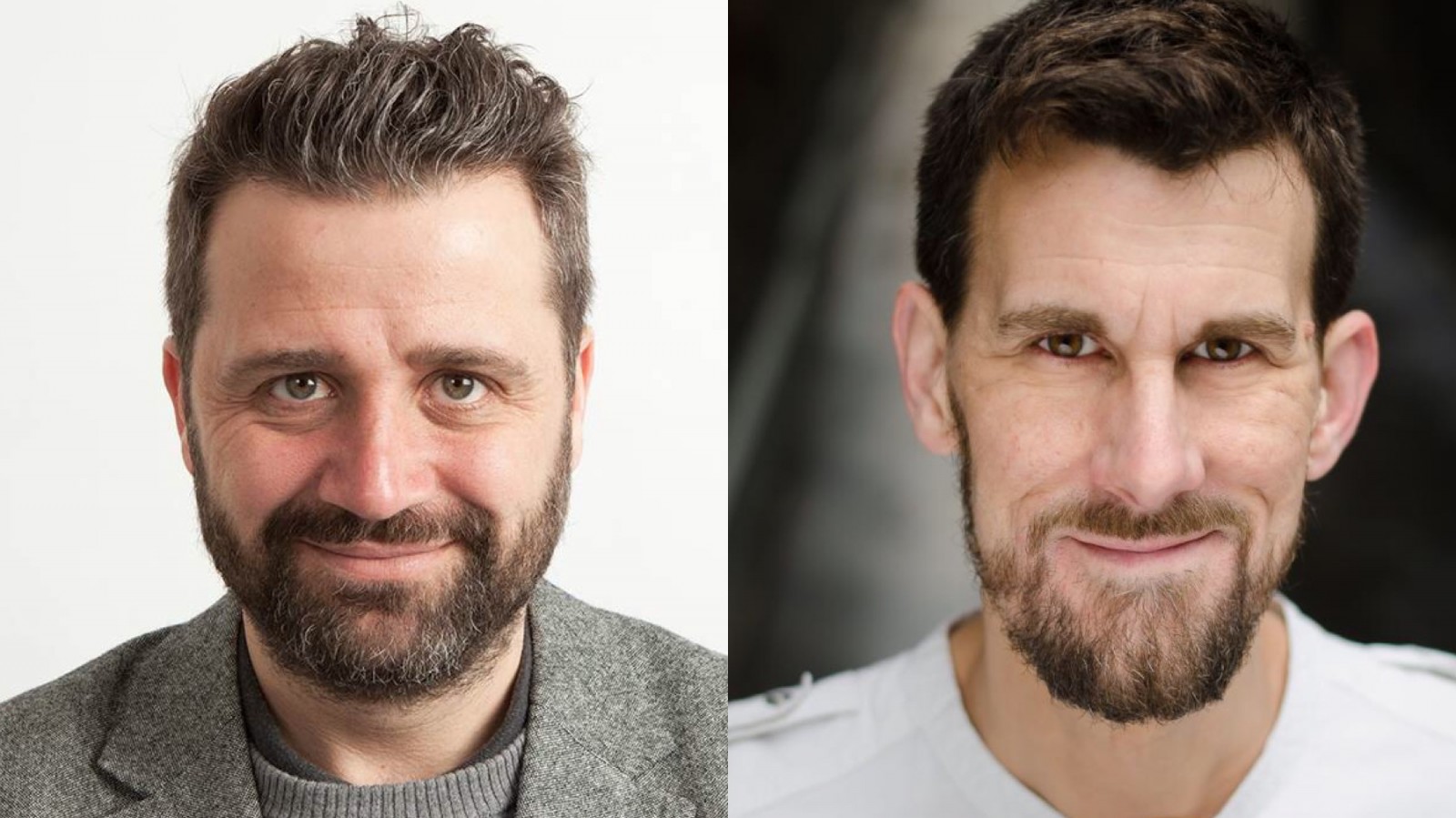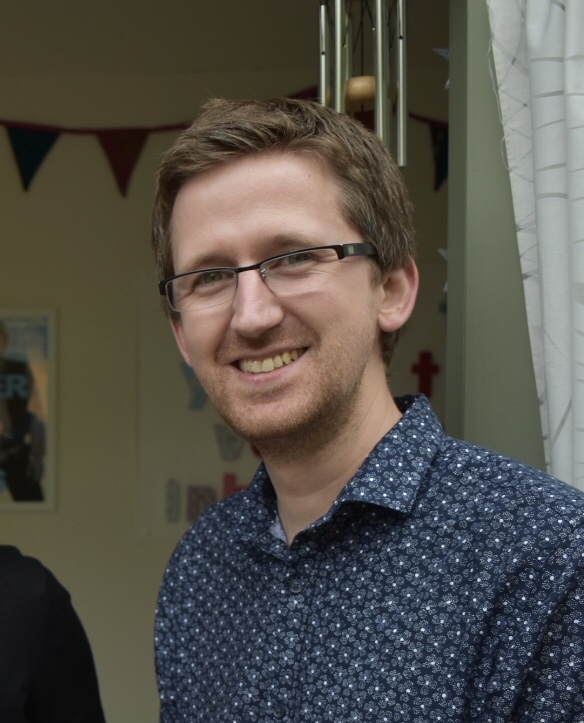Your cart is currently empty!

Phil Earle &
Michael Wagg
After Phil spotted the badge on Waggy’s cap we started talking about Edgar, and decided to make a badge the starting point for our story. We love the fact that stories can be found in the smallest, most ordinary things. You just have to keep your eyes and ears open to them.
Phil Earle & Michael Wagg

Edgar & Adolf is the brilliant and emotive story of an English-German friendship before the start of the Second World War. It is based on the real lives of two footballers who played for opposing teams: Dulwich Hamlet F.C. and Altona F.C. 1893. Phil Earle and Michael Wagg, do a wonderful job of filling in the gaps in what we know about these footballers’ lives, whilst keeping the story believable and heart-warming. We are left with a poignant reminder that even in the most awful of conflicts, a real friendship can transcend anything.
I’d like to thank Phil and Michael in joining us in the VIP Reading blog to talk about Edgar & Adolf.
Firstly, congratulations on Edgar & Adolf, which I thoroughly enjoyed reading. Without giving too much away, can you tell us a little bit about the story?
Thanks so much for your support. We’re really glad you enjoyed reading Edgar & Adolf. It’s a fictional story inspired by real lives, about a friendship between two footballers, who as you say played for teams in different countries, around 100 years ago. We asked ourselves the question ‘what if?’ and set our teenage hero, Adi, off on a mission to discover more about them, and to return a simple yet very precious object.
I read that the inspiration behind the story came from a badge on Waggy’s (Michael Wagg’s) hat, is that correct and can you elaborate?
Yes, it was a small button badge showing the face of the young Edgar Kail, who was a Dulwich Hamlet footballer in the 1920s and 30s. The amazing thing is that he is a hero to fans of the club today and they still sing about him at every match.
After Phil spotted the badge on Waggy’s cap we started talking about Edgar, and decided to make a badge the starting point for our story. We love the fact that stories can be found in the smallest, most ordinary things. You just have to keep your eyes and ears open to them.
You both obviously carried out a lot of research for the book, what were the most surprising discoveries along the way? Did anything have to be omitted from the book?
We love the fact that the real Edgar Kail played for the England team (as does the Edgar in our book) despite playing as an amateur for a relatively small club. Adolf Jäger played for his country too and was the Germany captain. We also enjoyed discovering things about their real lives off the pitch – like that Edgar was a drinks salesman and later moved from London to Scotland; and that Adolf owned some shops, including a tobacconist. We couldn’t include everything and had to decide which elements to use and what we might want to change for the book, to keep the story focused on Adi’s mission. We hope that readers might want to go away and find out more about the real Edgar & Adolf after they’ve read the book.
In the book, the chronology is cleverly used to flick between present-day and the past in order to tell the story. Was it always your intention to tell the story in this way?
In the story Adi is on a journey of discovery and we wanted the reader to go on that journey with him. So it felt important to be able to learn things at the same pace as Adi, and in the same way – looking at it though his eyes. Adi learns about the past by talking to Edgar and by looking through the old letters and newspaper articles they share with each other. Edgar learns things too, in the same way. It all happens one afternoon, over a few hours, but by using the things they share we were able to travel back in time, and also help Edgar remember how he felt when he was younger – when he was a similar age to Adi.
What was it like writing for the new Super-Readable Rollercoasters series with Oxford University Press?
It was great. We definitely wanted the book to be ‘super-readable’ and we hope it’s a rollercoaster, too! Supporting your football team can feel like a rollercoaster sometimes. But most importantly we wrote the book specifically for Barrington Stoke and their new collaboration with OUP, because we know they really care about good stories that are accessible to young people, including those who might be less confident or who find reading difficult because of dyslexia.
Was this your first experience of writing a dyslexia-friendly book and what were the challenges and the positives of this task?
Phil has written books for Barrington Stoke before and really enjoys working with them, and as we worked together Waggy was learning from Phil all the time. It was helpful, and rewarding, to keep in mind that we wanted the story to be really clearly told and for it to have a forward momentum – so that readers are keen to turn the page. I guess we saw each scene as opening a door to the next one, and we wanted the door to stay open. I think that was helped by the fact that we wrote it together: when one of us sent a chapter to the other, that was also like opening a door into what might happen next. It was tricky at times to get the structure right, but no-one said it was easy! It was great fun to write together.
I read that you had endeavoured to include the known facts about Edgar and Adolf, but that you wished to explore the unknown in an imaginative way. Did you ever worry about the fictional events that were added to enhance or fill in the gaps within the story?
The book is a celebration of these two footballers, Edgar & Adolf, and a celebration of friendship too. We wrote it out of love and respect for them and we hope that shines through. Keeping that respect in mind we allowed ourselves to use our imaginations, including some of the facts and changing others as we went along, making it clear at the beginning that our story is a fictional account of what their relationship might have been. Still we hope that we’re somehow ‘true’ to the spirit of these two real people, by trying to bring them to life as fully-rounded, believable characters.
In the author notes, you mention that the pair of you have been friends for over 30 years, how did that influence the book?
It made it a lot of fun to write. We enjoyed bouncing ideas off each other – and the idea of opening the door for the other one at the end of each chapter. We were also able to encourage each other at times when either one of us might have been struggling to know what to write next. In the end the story is about a really strong friendship and about respect too, so that made it easier to write – because we are such good friends and we respect each other’s ideas. We were able to push each other too, to have another go, to try something else, to keep going.
In learning more about Edgar and Adolf, were you surprised to discover that both sets of fans still remember these players in such affectionate ways?
This is the extraordinary thing. We knew that they’re both still remembered and celebrated by the fans, but yes that still surprises us. They must have been very special players and people. If you ever get a chance to go to a match at either Dulwich Hamlet or Altona 93 we’d really recommend it. The fans of both clubs are very welcoming and the atmosphere at the grounds is great. Both clubs have men’s and women’s teams and teams for younger age groups. If you go there you’ll see that the road that leads to the Dulwich Hamlet stadium is called ‘Edgar Kail Way’ and the Altona stadium is named after Adolf Jäger.
You can sing the song too: “Edgar Kail in my heart …”
On your journey in creating the book, were you able to speak to fans, visit the stadium and speak to people close to the story? How did that shape your perspective on the story?
Waggy has been a Dulwich Hamlet supporter for over ten years and Phil has seen lots of their matches too. In fact Waggy and his wife got married on the pitch at Dulwich Hamlet and Phil was there that day – he sang a song in the clubhouse before (and after) the wedding! Waggy also has friends who live in Hamburg and are Altona 93 supporters, so it was easy to talk to people who could tell us more about the players and the history of both clubs. There are lots of friendships between fans of the two clubs today, and we were able to get a good sense of the spirit of Dulwich and Altona by chatting to them.
Hypothetical, of course, but if you could meet the real Edgar and Adolf, what would you like to say to them?
Over ‘ere son, on me ‘ead!
Finally, can you describe this book in three words?
Friendship is everything.

Q & A hosted by
Rob McCann